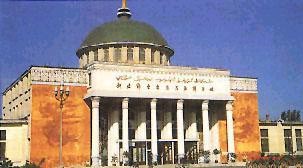 |
The Museum of Xinjiang Uygur Autonomous Region is a provincial level comprehensive historical museum in China. Located at the Xibei Road in Urumqi, the museum was constructed in 1953 and opened to the public on October 1, 1963.
The museum boasts a collection of 32,000 cultural relics, 288 of which are of the national first class. The articles on display at the museum highlight archaeological finds from the Silk Road and local cultural relics, including silk, pottery and porcelain, terra-cotta figures, weapons, documents written in different languages, and Mummies of Urumqi, as well as various articles of 12 local ethnic groups, giving a vivid introduction to the customs and cultures of different ethnic groups.
The Mummies of Urumqi display some preserved bodies of men, women and babies discovered in the vast desert. The corpses include a baby who died around 3,800 years ago, still wrapped in swaddling. The most famous, however, is the Luolan Beauty, a corpse of a woman believed to have died in her 40s and be of Indo-European ethnicity. Discovered in 1980 in the riverbed of the Tieban in Loulan City, the corpse is believed to be around 4,000 years old. When found, she was still clutching a small purse and wore leather and fur sandals. It ranks as the earliest and best-preserved mummified body in China.
The Museum features two basic displays: the Display of Xinjiang Historical Relics and the Display of Xinjiang Folklore. It has held a number of exhibitions at home and abroad, including the Primitive Society of China, Xinjiang Mummies, Xijiang from the Han to Tang Dynasties (206BC-907AD), Xinjiang Excavations, and Paintings Collected by the Museum, etc.
Publications of the Museum includeThe Silk Road,Excavations of Xinjiang, andThe Xinjiang Regional Museum, etc.